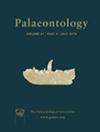Contrasting patterns of disparity suggest differing constraints on the evolution of trilobite cephalic structures during the Cambrian ‘explosion’
IF 2.3
2区 地球科学
Q1 PALEONTOLOGY
引用次数: 1
Abstract
Trilobites are an abundant group of Palaeozoic marine euarthropods that appear abruptly in the fossil record c. 521 million years ago. Quantifying the development of morphological variation (or ‘disparity’) through time in fossil groups like trilobites is critical in understanding evolutionary radiations such as the Cambrian ‘explosion’. Here, I use geometric morphometrics to quantify ‘cumulative disparity’ in functionally‐important structures within the trilobite cephalon across their initial radiation during Cambrian Series 2. Overall cephalic disparity increased rapidly and attained a maximum within several million years. This pattern is dominated by the cephalic outline (in particular the genal spines), reflecting rapid, convergent expansion to the extremes of morphospace in a few early families. In contrast, removing the outline and focusing on structures such as the glabella and eye ridges (associated with feeding and vision, respectively) showed a more gradual increase in disparity, closer in line with taxonomic diversity and supporting the hypothesis of a relatively accurate trilobite fossil record. These contrasting patterns suggest that disparity in different structures was constrained in different ways, with extrinsic (ecological) factors probably having the major impact on overall disparity. It also implies that patterns of disparity in isolated substructures cannot necessarily be taken individually as representative of overall morphologies.差异的对比模式表明,在寒武纪“大爆发”期间,三叶虫头部结构的进化受到了不同的限制
三叶虫是一组数量丰富的古生代海洋真节肢动物,约5.21亿年前突然出现在化石记录中。量化三叶虫等化石群随时间的形态变化(或“差异”)的发展,对于理解寒武纪“爆炸”等进化辐射至关重要。在这里,我使用几何形态计量学来量化寒武系期间三叶虫头类在其初始辐射期间功能重要结构的“累积差异” 2.总的头部差异迅速增加,并在几百万年内达到最大值。这种模式主要由头部轮廓(尤其是老年棘)决定,反映出在少数早期家族中,形态空间迅速、收敛地扩展到极端。相比之下,去除轮廓并关注眉间和眼脊等结构(分别与进食和视觉有关)显示出差异的逐渐增加,更符合分类多样性,并支持相对准确的三叶虫化石记录的假设。这些对比模式表明,不同结构中的差异以不同的方式受到约束,外部(生态)因素可能对整体差异产生主要影响。这也意味着,孤立子结构中的差异模式不一定能单独作为整体形态的代表。
本文章由计算机程序翻译,如有差异,请以英文原文为准。
求助全文
约1分钟内获得全文
求助全文
来源期刊

Palaeontology
地学-古生物学
CiteScore
5.60
自引率
3.80%
发文量
43
审稿时长
6 months
期刊介绍:
Palaeontology publishes a wide variety of papers on palaeontological topics covering:
palaeozoology
palaeobotany
systematic studies
palaeoecology
micropalaeontology
palaeobiogeography
functional morphology
stratigraphy
taxonomy
taphonomy
palaeoenvironmental reconstruction
palaeoclimate analysis and biomineralization studies.
 求助内容:
求助内容: 应助结果提醒方式:
应助结果提醒方式:


